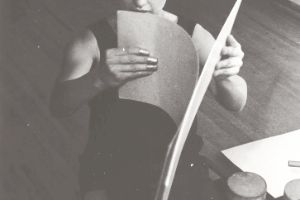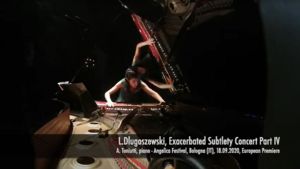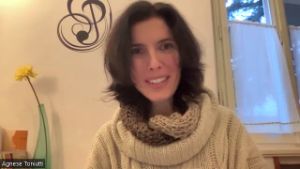
Lucia Dlugoszewski performing “Geography of Noon”
Courtesy of the Erick Hawkins Dance Foundation, Inc.
Lucia Dlugoszewski
“There is something about listening which reaches beyond all concerns with pattern, information, symbol, language, communication – something about sheer listening so extraordinary that it causes people to dedicate their lives as composers, musicians, listeners.”
Lucia Dlugoszewski
How Not to be Famous
The composer, performer, inventor of instruments, author and choreographer Lucia Dlugoszewski
“She did what I always say to my students. Keep your freedom, earn some money and fly under the radar.” There is a gleam in the eye of New York-based trombonist David Taylor, a close friend of Lucia Dlugoszewski, when he talks about his long-term artistic associate, who composed a number of works especially for him. However, he is wrong about one of those three things. Lucia Dlugoszewski, who died in New York in the year 2000, may have spent almost all her time operating outside the gaze of the music scene. And today she remains more or less unknown not only in Europe, but also in the USA. She has also always maintained her freedom. But the money never really worked out. Everything she earned (and there was not much) immediately went back into her work as an artist.

Lucia Dlugoszewski with score and thimbled fingers for “8 clear places”
Courtesy of the Erick Hawkins Dance Foundation, Inc.
1
EARLYDAYSINDETROITANDNEWYORK
The music that I “am too old to write”
Lucia Dlugoszewski came into the world in 1925 (not, as she sometimes herself claimed, in 1931) in Detroit, as the daughter of Polish immigrants. Her talent for the piano, for writing and even for composing was evident at an early age. In 1948 she was awarded a scholarship to go to New York, where she took private lessons with John Cage, Edgard Varèse and the pianist Grete Sultan, who soon became close friends, even if John Cage claims to have difficulty with her name when writing a letter to Pierre Boulez about two talented students: “The son is called Christian Wolff. I don’t know the Pole’s name, it is too difficult.”
When Arnold Schönberg visited his former student John Cage in 1950, Lucia Dlugoszewski was also invited and played one of her piano sonatas. The old master drily described the piece as “…one of the bold kinds of new music I am too old to write.” Dlugoszewski’s first stages were the studios of artists and musicians who were her friends or little jazz clubs like The Five Spot in New York. Here she did not just play her sonatas, from the start she also played on the inner workings of the piano and on everyday objects such as glass, paper, porcelain, boiling and whistling kettles, typewriters and boxes of matches. On these occasions she would draw a curtain between herself and the audience so that – unlike with John Cage – nothing they might see could distract them from what they heard.

Agnese Toniutti performs “Exacerbated Subtlety Concert (Why Does a Woman Love a Man?)” by Lucia Dlugoszewski.
Lucia Dlugoszewski – she pronounced her Christian name “Loosha” – was obsessed with sound. For the dance productions of Martha Graham’s pupil Erick Hawkins, to whom John Cage had recommended her, she not only wrote highly virtuosic scores, she also invented new instruments: harps made of wood, glass, metal and paper, rattles and square drums. She also devised a series of percussion instruments that are reminiscent of Chinese hand drums, looking partly like table tennis bats and partly like axes. These had balls fixed to their sides on strings that would strike the surface of the object when it was twisted.
“I wanted to help the ear hear sound for its own sake.”
Lucia Dlugoszewski
2
AESTHETIC
Radical, Pure, Immediate
Lucia Dlugoszewski articulated her aesthetic in letters and theoretical writings but also in the crazy collage titles she gave to her works, such as “Disparate Stairway Radical Other” or “Tender Theatre Flight Nageire”. Among her key concepts, “theatre” stands for the immediacy of experience, “radicality” for her intense desire to touch the listener and “flight” for both risk and utopia.
“I was also more aware than ever before or since of the fragility of sound when it is music. I was committed to a pure radical empirical immediacy, beyond Classicism and Romanticism – a commitment to make music itself, to make music sound, to make music alive…” (Lucia Dlugoszewski, “What is Sound to Music?”, in: “Main Currents in Modern Thought”, 30/1, 1973)
“The first concern of all music in one way or another is to shatter the indifference of hearing, the callousness of sensibility, to create that moment of solution we call poetry, our rigidity dissolved when we occur reborn – in a sense, hearing for the first time. ‘Tender Theater Flight Nageire’ is actually a series of musical rituals involved somehow with the poetic roots of erotic experience.”
Lucia Dlugoszewski
3
DANCE
Erick Hawkins Dance Company
The Erick Hawkins Dance Company became Lucia Dlugoszewski’s most important and practically her sole sphere of activity. Not only because she and Hawkins were a couple. But also because her music would soon be created directly out of their choreographic work. Dlugoszewski was aware that her compositions could have held their own on the concert platform. Yet she never bothered looking for a publisher. If her works had been tied to a publisher, the Hawkins Dance Company might no longer have been able to afford the rights for their own productions. This is another reason why her oeuvre remains almost unknown until now.

Katherine Duke, Artistic Director of Erick Hawkins Dance, performs “Fountain in the Middle of the Room”. Choreography and music by Lucia Dlugoszewski.
Only briefly, for a while at the beginning of the seventies, had Dlugoszewski shown up on the music world’s radar. In 1975 Pierre Boulez conducted the world premiere of her trumpet concerto “Abyss and Caress”. And in 1980 she became the first woman ever to win the Koussevitzky International Recording Award for her orchestral work “Fire Fragile Flight”. The fact that she did not attract further international attention is a surprise. The major reason for her continuing to fly under the radar – and why earning money would always be a concern – was the dance company, which she led after Erick Hawkins’s death.

Lucia Dlugoszeski with paper rattle for “8 clear places”
Courtesy of the Erick Hawkins Dance Foundation, Inc.
Her music remains to be discovered: work that is searching for ecstasy, full of surprises, the pent-up energy of movement, sonic imagination, virtuoso challenges, associative, impulsive and constantly striving towards a moment of intensity. Anyone who listens to the beginning of the solo “Space is a Diamond” will hear a trumpet that seems to defy gravity on a relentless journey into new, more extreme registers. And in the string quartet “Disparate Stairway Radical Other” the energy of the movement seems inexhaustible. Sometimes the figures are clear and ancient, then they are playful and often repetitive. Memories are also evoked of Far Eastern music, but staged with almost excessive confidence, quite unlike the contemporaneous works of her reverential and academic European colleagues.
Perhaps it was significant that Lucia Dlugoszewski herself always continued to be a performer: either on the “timbre piano”, as one critic called the piano that she played, or with her own range of instruments. She took “theatre” seriously, as David Taylor recalls: “Sometimes you don’t know why you are on stage. Sometimes it’s because you want to present yourself, but sometimes it’s also because you want to get the music across and draw attention to yourself at the same time. With her, it was just all about the immediacy: get it across. Get what we feel, our statement, our entire bodies across.” Many people have certainly tried. However, anyone who listens to Dlugoszewski’s music will not associate it with the similar sounding slogans of composers’ self-promotion. Instead, they will discover an oddly intense fusion of ascetic rigour and the luxuriant thrill of sound, of extreme virtuosity and the unbridled joy of play.
— Martina Seeber
4
LUCIADLUGOSZEWSKIINTHISYEAR’SPROGRAMMEOFMAERZMUSIK
Contemplations into the Radical Others
Works by Lucia Dlugoszewski in the Programme of MaerzMusik 2023
Agnese Toniutti
Agnese Toniutti is an Italian pianist specialised in contemporary and 20th century music. She dedicates herself to the exploration and research on peculiar piano repertoire, often revolving around the concept of sound and its role in musical composition, investigating the complementarity of composition and improvisation in musical creativity, both as an author and as interpreter. Her solo recitals are often thematic or monographic, carefully interweaving live performance with extracts from writings and audio documents selected after musical, bibliographical and archival study. Among them: the monographical “portrays” of Giacinto Scelsi, John Cage, Giancarlo Cardini, and the recitals dedicated to Fluxus movement (featuring premieres by Philip Corner and Dick Higgins) and to women’s creativity from the 1950s to nowadays (including Lucia Dlugoszewski’s “timbre” piano research project). Among Toniutti’s recent projects is the release of “Subtle Matters” (Neuma Records, 2021) featuring compositions by Lucia Dlugoszewski, Tan Dun and Philip Corner.

Agnese Toniutti
© Laura Battel

Agnese Toniutti in conversation with Sophie Emilie Beha about Lucia Dlugoszewski, the flow in her music and how Toniutti made herself a score for Exacerbated Subtlety Concert.
Ensemble Musikfabrik
Ever since its formation in 1990, Ensemble Musikfabrik has had the reputation of being one of the leading ensembles for contemporary music. Following the literal meaning of its name, Ensemble Musikfabrik is particularly dedicated to artistic innovation. New, unknown, and often personally commissioned works in unusual media are typical of their productions. The results of their extensive work, usually taking place in close collaboration with the composers, are presented by the Cologne-based international soloist ensemble in about 80 concerts a year in both Germany and abroad, at Festivals, in their own series “Musikfabrik in WDR” and in regular radio recordings and CD productions. The musicians themselves take the responsibility for making all-important decisions. Exploring forms of modern communication, and new possibilities for expression in musical and theatrical areas, are a focal point. Interdisciplinary projects that can include live electronics, dance, theatre, film, literature and creative artists, along with chamber music, and the confrontation with works using open form and improvisation, extend the traditional conducted ensemble concerts.

Ensemble Musikfabrik
© Frederike Wetzels
Inventor of Instruments
Lucia Dlugoszewski invented over 100 percussion instruments. Commissioned by MaerzMusik, the instrument maker Thomas Meixner has recreated some of them for the Ensemble Musikfabrik, based on sketches by Dlugoszewski. They can be heard for the first time at the concert on 24 March 2023 at the Haus der Berliner Festspiele.
Contributors
Martina Seeber
Martina Seeber is a musicologist and journalist. She presents radio shows, talks and live concerts and reports on New Music for SWR in Stuttgart.
Editors MaerzMusik Story
Sophie Emilie Beha, Kamila Metwaly, Paul Rabe
Funded by

“Contemplations into the Radical Others” is a long-term project of MaerzMusik in cooperation with the Erick Hawkins Dance Company, Ensemble Musikfabrik, Agnese Toniutti and many others.





